Upcoming Events
Past Events

Launch of RedTalk by School of Humanities & Social Sciences
The podcast aims to foster open dialogue, challenge societal norms, confront deep-rooted biases, and address concerns often overlooked or stigmatized in our society. Drawing on sociocultural and historical lenses, Red has symbolized risk, vulnerability, taboo, sanctity, and rebellion among many other things.

End of Fall Semester Classes (Freshmen + Higher Semester students)
End of Fall Semester Classes (Freshmen + Higher Semester students)
Beginning of End Semester Examinations
All the best to all the students for their Exams!
School of Design & Architechture Unbuilt Vision
School of Design & Architecture organises event called "Unbuilt Vision" which gives students a platform to showcase their projects to industry experts.
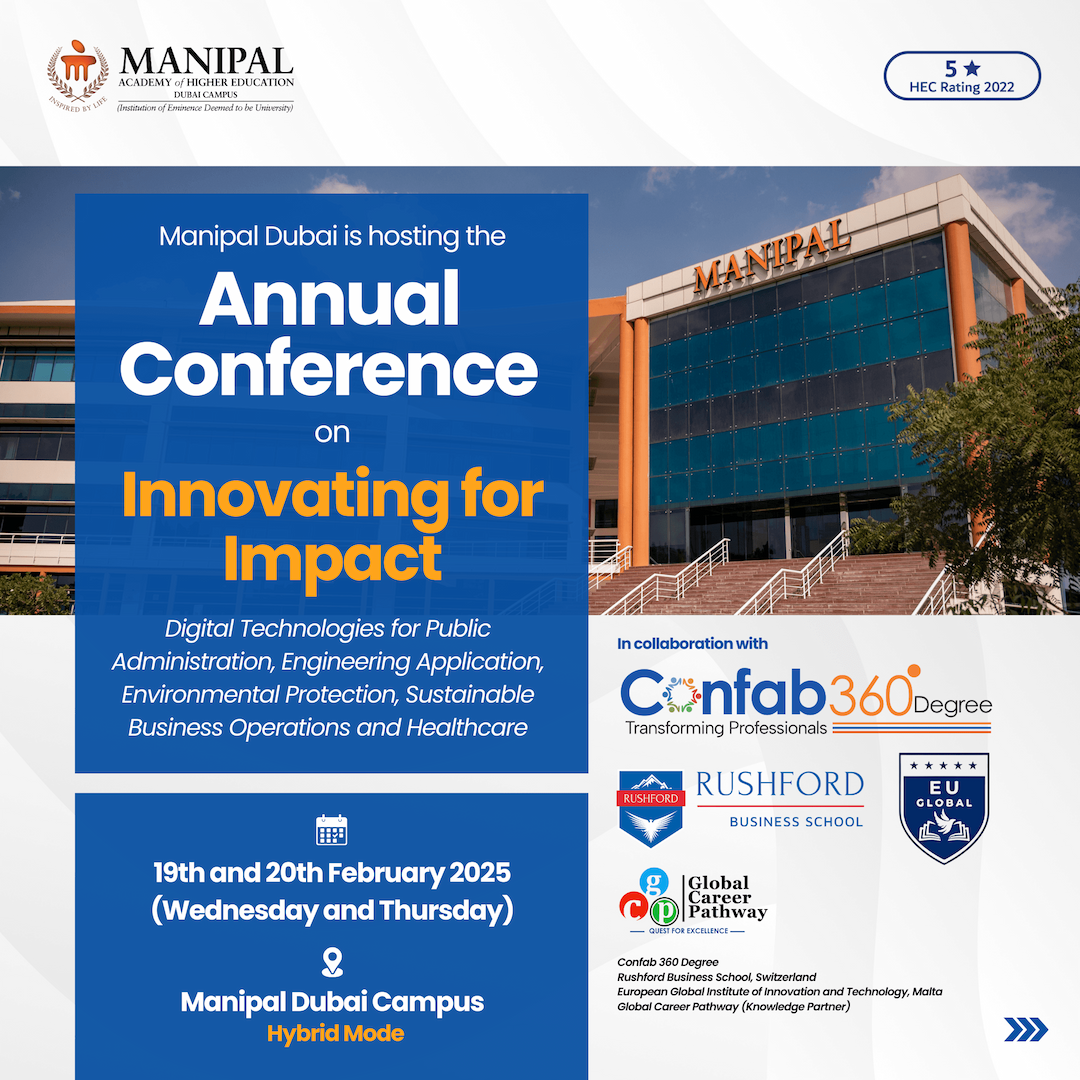
Annual Conference on Innovating for Impact
Manipal Dubai invites you to the Annual Conference on Innovating for Impact, a landmark event focused on exploring the transformative potential of digital technologies across multiple sectors.
Manipal Sports Fest Phase 2
Get ready to experience the excitement and sportsmanship of MSF 2024-2025 as we move forward with Phase 2 of this grand event!
Commencement of Winter Semester
We are excited to announce the beginning of the Winter Semester for the academic year 2024-2025!
Carnival 2025
Get ready for the most awaited cultural celebration of the year!
End of Winter Semester 2025
Let’s prepare to wrap up this chapter with pride and anticipation for the future.

End Semester Exams: Starting 11 June 2025
The End Semester Exams for the academic year 2024-2025 are scheduled to begin on 11 June 2025.

Speaking with Influence and Leading with Impact
Join us for an inspiring session with Su Bridgman, a renowned communication industry specialist
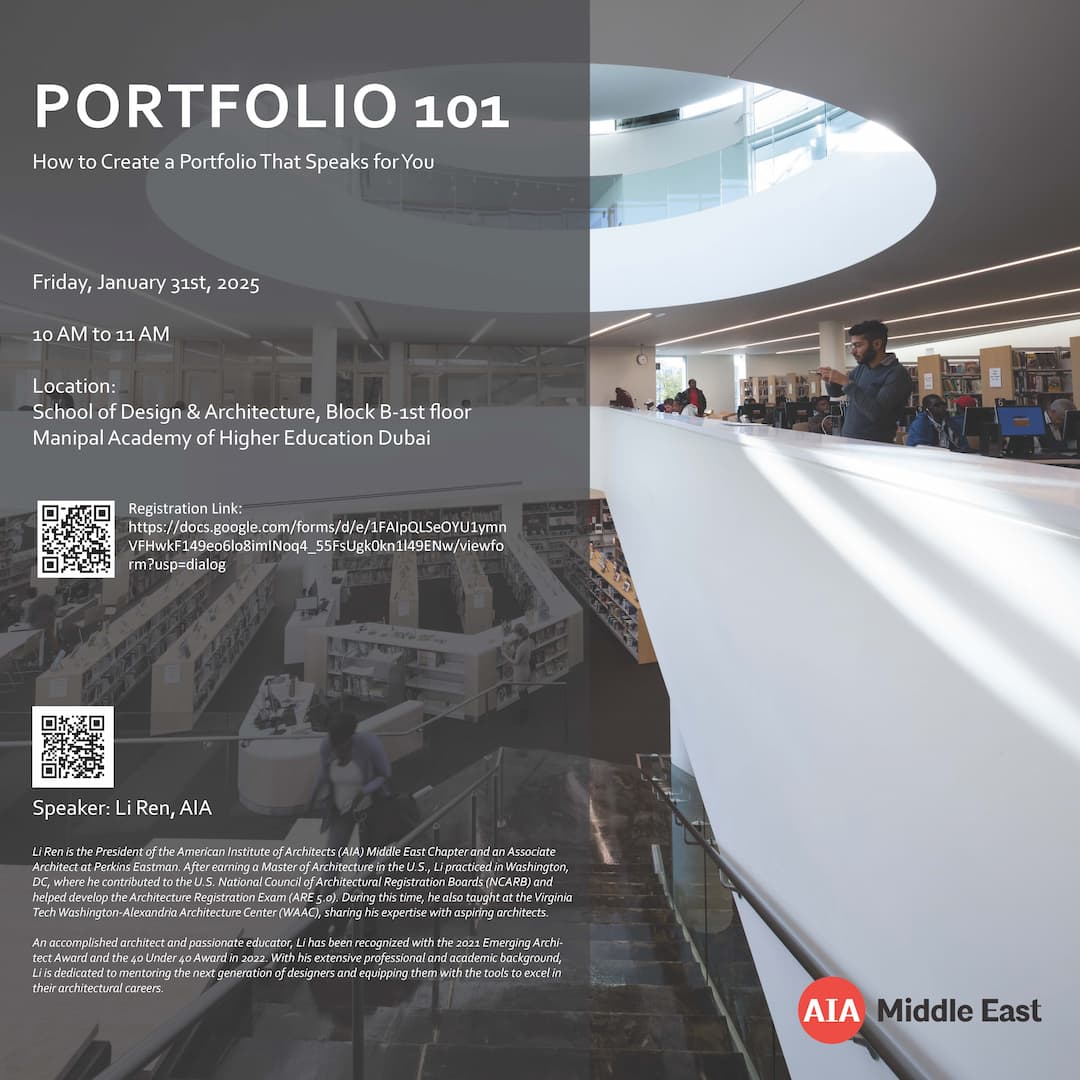
Portfolio 101 – Create a Portfolio that Speaks for You
Manipal Dubai proudly hosts a session by the American Institute of Architects (AIA), exclusively for architecture students.
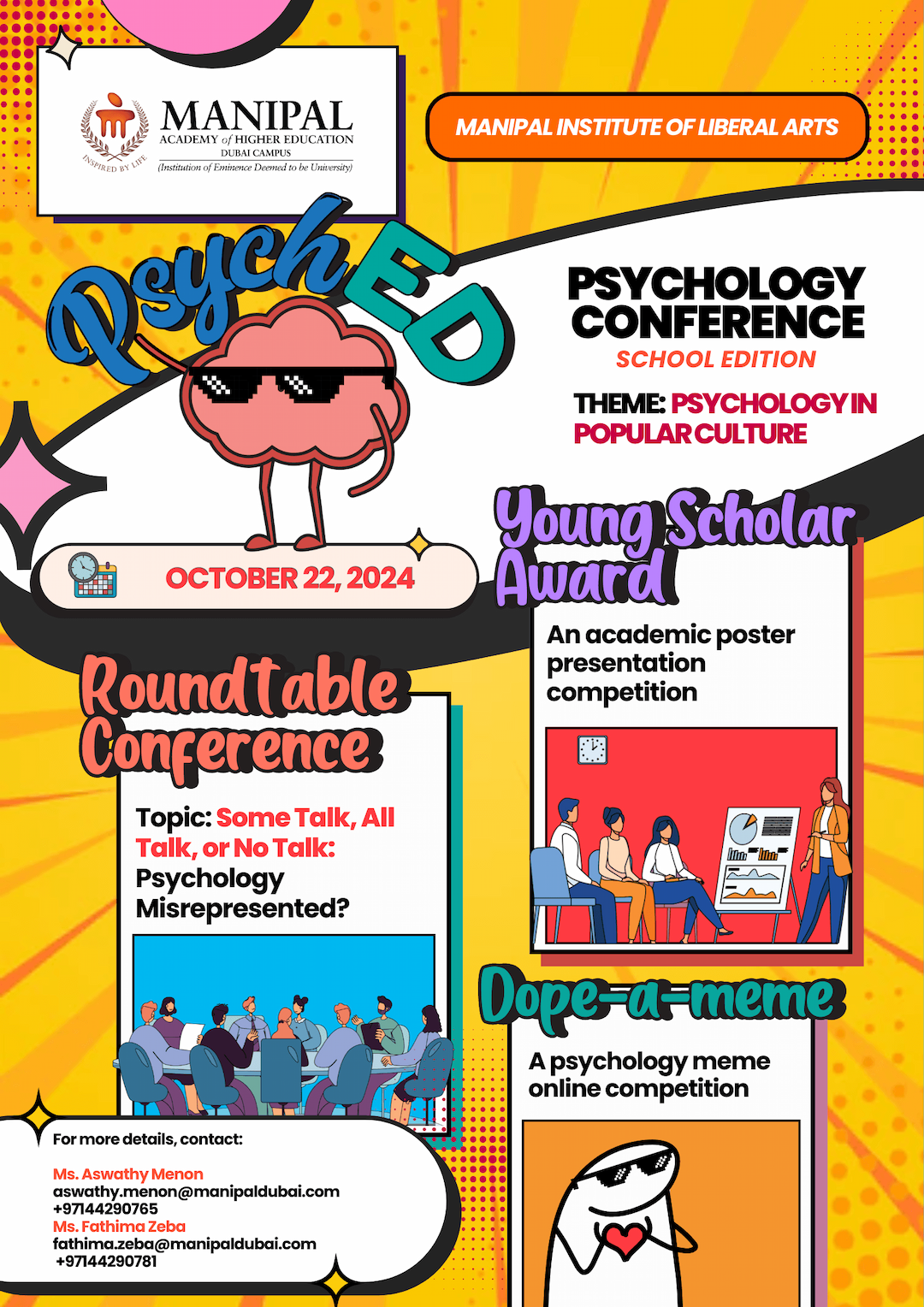
PsychED - Psychology Conference - School Edition
Welcome to PsychED, the Psychology Conference – School Edition, hosted by the Manipal Institute of Liberal Arts at Manipal Academy of Higher Education (MAHE), Dubai! After a successful second edition, we are thrilled to announce the third edition of PsychED. PsychED is a platform for students to engage in academic discussions and learn more about psychology. Our conference is open to students from schools across the UAE who wish to enhance their knowledge and participate in engaging intellectual dialogue. This year’s theme is Psychology in Popular Culture, which aims to explore and comment on how psychology is represented in popular culture and the influence both areas have on each other. We invite students from Grade 9/Level 8 and above who are interested in psychology to participate in this event. The conference will be held on October 22nd, 2024, and will feature an expanded range of activities and prizes.
Freshmen Orientation - 2024
Welcome aboard! You are now part of Manipal Academy of Higher Education, Dubai Campus, a 5 Star Rated University (KHDA Ratings 2020). It gives us immense pleasure to invite you to the Freshmen Orientation for Academic year 2024-25. We also take this opportunity to congratulate you on being the 24th batch at MAHE Dubai.

International Student Research Colloquium 2024 | School of Humanities & Social Sciences
2nd International Student Research Colloquium 2024 organized by School of Humanities & Social Sciences, MAHE, Dubai

Launching REDTalk
Get ready for REDTalk – a podcast series brought to you by the School of Humanities & Social Sciences!

2nd Symposium on Recent Trends in Mathematics, Statistics and Engineering 2024| School of Engineering & IT
School of Engineering and IT, MAHE Dubai, is organizing the 2nd Symposium on Recent Trends in Mathematics, Statistics, and Engineering

Virtual Open House - 30th August 2023
Manipal Academy of Higher Education, Dubai Campus – rated 5-Star by KHDA, Dubai in the latest Higher Education Classification Rating 2022 – is organizing a Virtual Open Day, exclusively for prospective students based in Africa, this Wednesday on 30th August 2023 from 5 pm onwards, Dubai Time.

Manipal International Symposium on Design (MiSD) | School of Design & Architecture
Co-hosted by Chartered Institute of Architectural Technologists (CIAT), UK, and Edinburgh Napier University, UK.

PsychED - Psychology Conference - School Edition
Welcome to PsychED, the Psychology Conference – School Edition, hosted by the School of Humanities and Social Sciences at Manipal Academy of Higher Education (MAHE), Dubai! After a successful second edition, we are thrilled to announce the third edition of PsychED. We invite students from Grade 9/Level 8 and above interested in psychology to participate in this event. With an expanded range of activities and prizes, the conference will be held in a hybrid format on December 4th and 5th, 2023.

Virtual Open House - 25th May 2023
Manipal Academy of Higher Education, Dubai Campus – rated 5-Star by KHDA, Dubai in the latest Higher Education Classification Rating 2022 – is organizing a Virtual Open Day, exclusively for prospective students based in Africa, this Wednesday on 25th May 2023 from 5 pm onwards, Dubai Time.

7th International Conference on Green Economy and Sustainable Growth through Strategic Change | School of Business
Organized by School of Business, MAHE, Dubai in collaboration with Department of Commerce, MAHE, Manipal and College of Banking and Financial Studies, Muscat, Sultanate of Oman.

Virtual Open House - 15th February 2023
Manipal Academy of Higher Education, Dubai Campus – rated 5-Star by KHDA, Dubai in the latest Higher Education Classification Rating 2022 – is organizing a Virtual Open Day, exclusively for prospective students based in Africa, this Wednesday on 15th February 2023 from 5 pm onwards, Dubai Time.

Virtual Open House - 31st January 2023
Manipal Academy of Higher Education, Dubai Campus – rated 5-Star by KHDA, Dubai in the latest Higher Education Classification Rating 2022 – is organizing a Virtual Open Day, exclusively for prospective students based in Africa, this Wednesday on 31st January 2023 from 5 pm onwards, Dubai Time.

International Student Research Colloquium 2023 | School of Humanities & Social Sciences
1st International Student Research Colloquium 2023 organized by School of Humanities & Social Sciences, MAHE, Dubai.

PsychED - Psychology Conference - School Edition
Welcome to PsychED, the Psychology Conference – School Edition, hosted by the School of Humanities and Social Sciences at Manipal Academy of Higher Education (MAHE), Dubai! After a successful debut, we are thrilled to announce the second edition of PsychED. We invite students from Grade 9/Level 8 and above interested in psychology to participate in this event. With an expanded range of activities and prizes, the conference will be held on May 3rd and 4th, 2023.

Polemics '22 - An Inter-School Debate Competition
Manipal Academy of Higher Education (MAHE) Dubai is back with Polemics 2022, An Inter-School Debate Competition happening on 7th of June. The objective of this event is to draw the attention of the student fraternity towards various current political, environmental, socioeconomic, or cultural issues. This would undoubtedly help in

MIMRC - 2022
Manipal International Media Research Conference, Dubai, 2022 organized by MAHE, Dubai

PsychED - Psychology Conference - School Edition
The School of Humanities and Social Sciences at Manipal Academy of Higher Education (MAHE) Dubai is hosting PsychED – A Psychology Conference, School Edition on the 31st of May. The conference invites students from Grade 9 and above, who are interested in psychology from schools across UAE to come together and engage in academic dialogue and test the competitive spirit of students through academic discussions and fun quizzes centered around psychology.

15th Annual Convocation
Manipal Academy of Higher Education, Dubai cordially invites you to the 15th Annual Convocation Ceremony to be held from 11th November to 13th November 2021

MAHE Dubai Toastmasters Club - Club Speech Contest
The MAHE Dubai Toastmaster Club Speech Contest will be conducted via Zoom, on 6th November 2021 from 3pm to 5pm GST.

MAHE Dubai - Young Shakespeare Award
The School of Humanities and Social Sciences at Manipal Academy of Higher Education (MAHE) Dubai presents the Young Shakespeare Award – An Annual Short Story Writing Competition in collaboration with Young Times, Khaleej Times. Launched on World Book Day, celebrated in the honor and memory of the great Shakespeare, this competition aims to encourage young budding writers in the UAE and provide a platform to showcase talent. This year’s competition will run from 23rd April to 23rd June 2022.

MAHE Dubai to participate at MITBMUN 2022
The students of the Literature Club and Orators Club are all set to participate in the upcoming model UN conference, organized by Potentia - The MUN Club of Manipal Institute of Technology, Bengaluru.

MAHE Dubai House of Arts Club - Call For Paintings & Sketches
The House of Arts Club, MAHE Dubai is currently calling all student artists of MAHE Dubai to contribute their work towards the theme “Resilience”.

MAHE Dubai Theatre Club - Meet for National Day Preparations
The Theatre Club, MAHE Dubai is currently calling all student performers to join the club, to discuss plots and scripts for upcoming events.

MAHE Dubai Verve Dance Club - Call For Auditions
The Verve Dance Club, MAHE Dubai is currently calling all student of MAHE Dubai to audition for any upcoming activities & events.

'WoW Manipal Dubai' - Freshmen Orientation Week, 2021
Welcome aboard! You are now part of Manipal Academy of Higher Education, Dubai Campus, a 5 Star Rated University (KHDA Ratings 2020). It gives us immense pleasure to invite you to the Freshmen Orientation for Academic year 2021-22. We also take this opportunity to congratulate you on being the 21st batch at Manipal Dubai.

MAHE Dubai Toastmasters Club - Club Debate Contest
The MAHE Dubai Toastmaster Club Debate Contest will be conducted via Zoom, on 18th September 2021 from 3pm to 5pm GST.

MAHE Dubai Unplugged
Unplugged, the first-of-its-kind virtual festival is an opportunity for students to showcase their talent and compete with their peers, while in the comfort of their homes.

Idea Challenge - Webinar Series - Creating Impactful Pitch Presentations
MAHE Dubai is hosting a Part 2 webinar of the MAHE Dubai Idea Challenge: Creating an impactful pitch presentation by Entrepreneur Mr. Mukhtar Jahangeer.

Idea Challenge Webinar Series - Ideation
Part 1: Ideation | Learn all about idea generation, solving problems and much more from renowned lecturer and strategy consultant Mr. Thasim Rafi.

AEIT - 2021
School of Engineering & Information Technology (SoE-IT), Manipal Academy of Higher Education, Dubai Campus proudly announces its 6th International Student Research Colloquium on Advances in Engineering & Information Technology on May 25th, 2021. Academicians, Industrialists, Research Scholars, Scientists, and Students from across the world are invited to share their experiences and findings of their studies in the fields of various disciplines of Engineering.

Masters' Project Plunge - School of Business
The School of Business, MAHE Dubai is organizing Masters' Project Plunge

Student Research Platform for MBA Students - Fall 2021 - School of Business
The School of Business, MAHE Dubai is organizing Student Research Platform for MBA Students - Fall 2021

Current Trends in Life Sciences: e-Seminar Series-2 | School of Life Sciences
The School of Life Sciences, under the aegis of ASM International Student Chapter, is organizing the second edition of e-Seminar series on “Current Trends in Life Sciences” on 29th April 2021.

Entrepreneurship - The Road Less Taken
A talk about how entrepreneurship is a unique field, and how family businesses differ from entrepreneurship.

Workshop on "Introduction to Robotics" | School of Engineering & IT
The workshop will be conducted in 2 parts: one on 11th March, and the second session on 18th March.

4th Symposium on IOT 2021 | School of Engineering & IT
The Electrical & Electronics Department, School of Engineering & IT is organizing a Symposium on Internet of Things on 1st April 2021.

E-Symposium - 2021
Call for Abstracts | E-Symposium 2021, organized by School of Business, MAHE Dubai

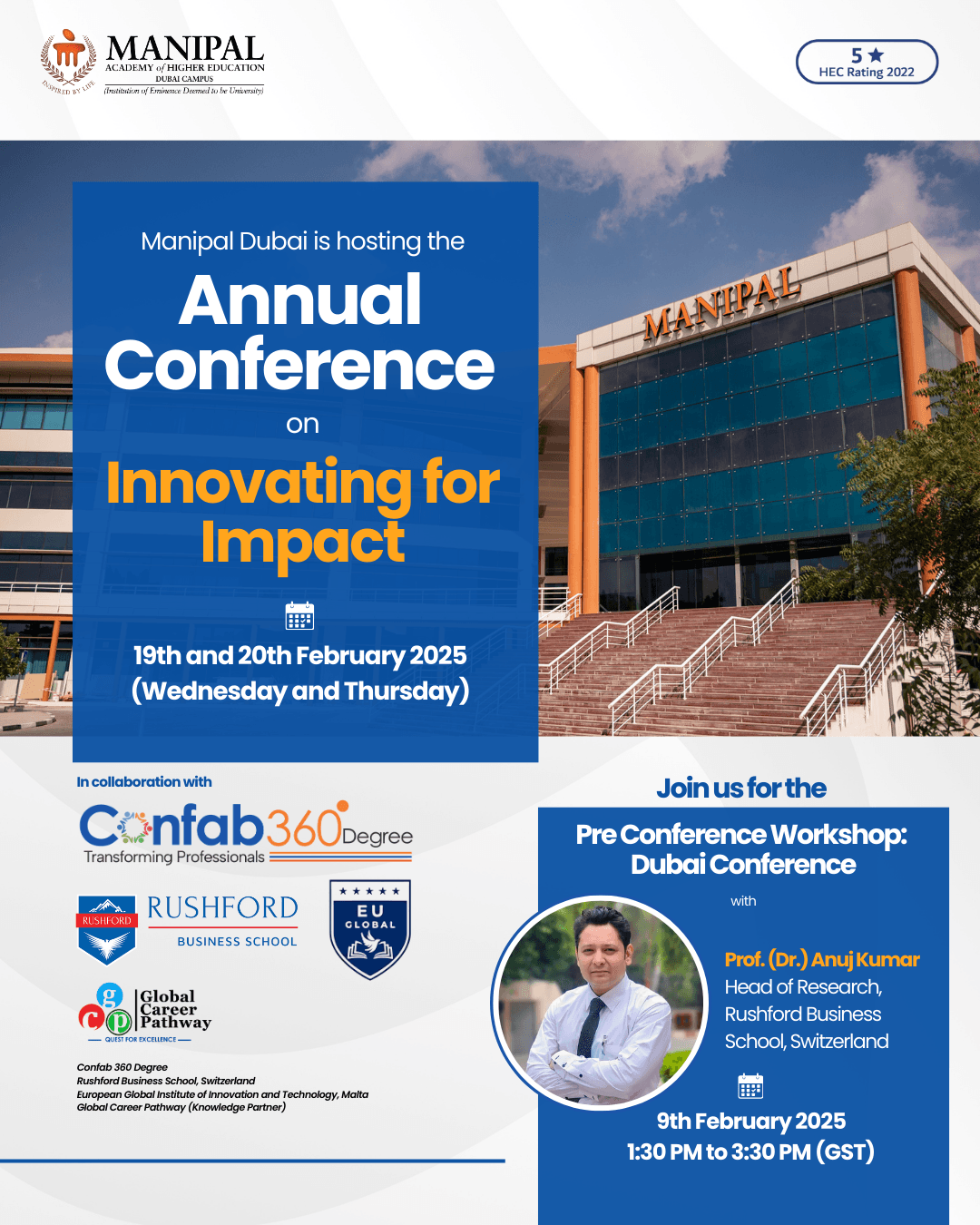
Pre-Conference Briefing: Innovating for Impact
This session aims to provide a comprehensive overview of the conference themes and objectives, ensuring attendees are well-prepared for the main event.

3-Day Acting Masterclass at Manipal Dubai
Hosted by: Manipal Institute of Liberal Arts in collaboration with Cininfo
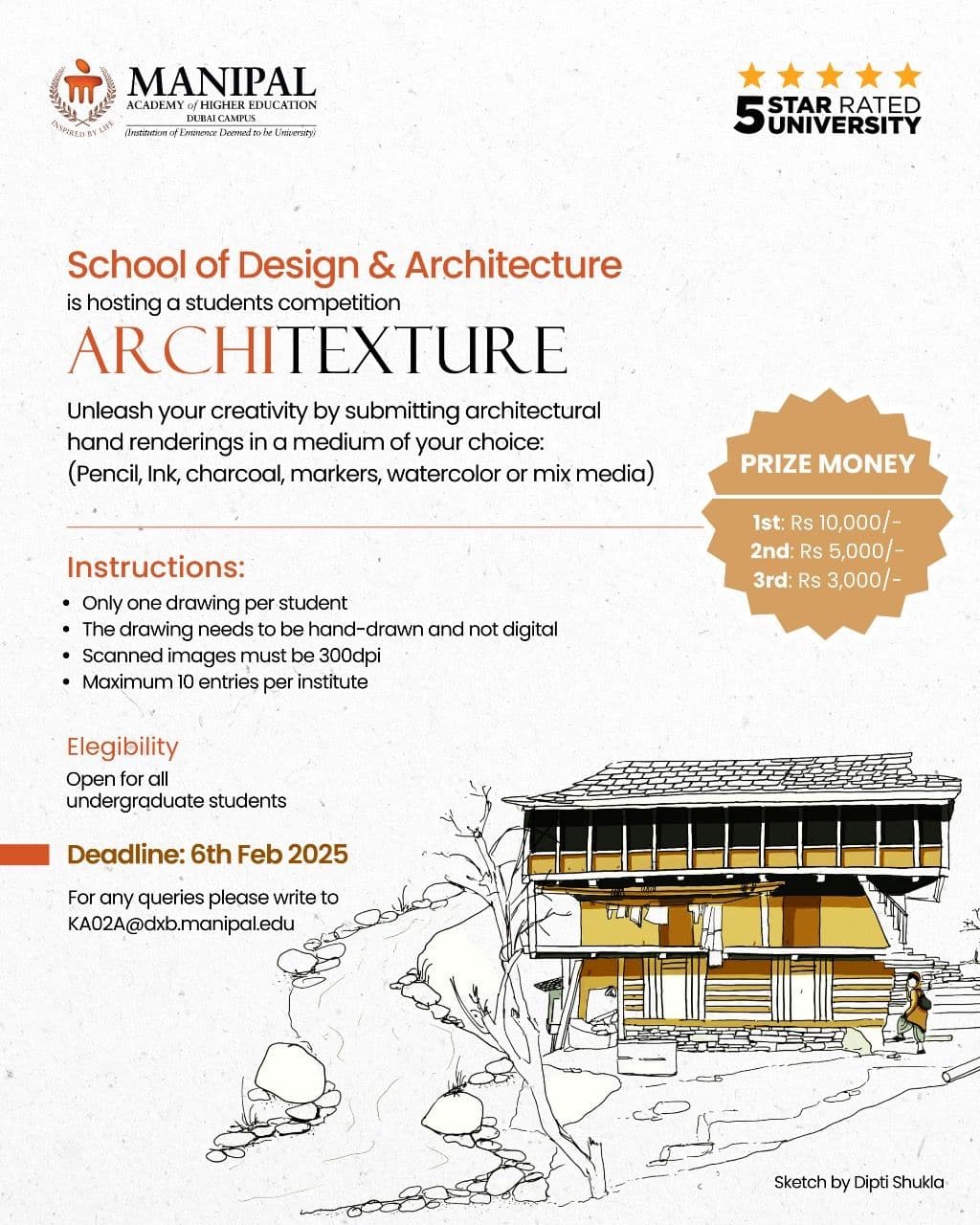
Manipal Dubai to host ARCHITEXTURE 2025 – An Architectural Design Competition
The School of Design & Architecture at Manipal Academy of Higher Education – Dubai is excited to announce ARCHITEXTURE 2025, an inter-university architectural competition open to students from universities under the Council of Architecture.

3rd International Student Research Colloquium 2025 | Manipal Institute of Liberal Arts
We are pleased to announce the Third International Student Research Colloquium hosted by the Manipal Institute of Liberal Arts, “Exploring New Horizons in Liberal Arts”.


